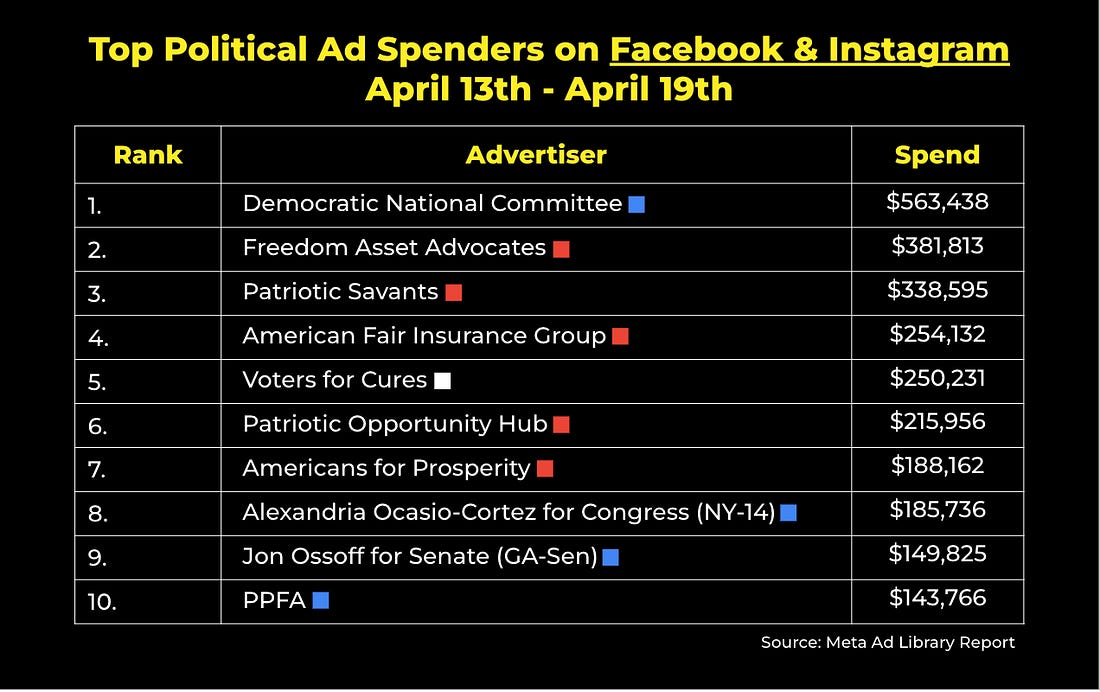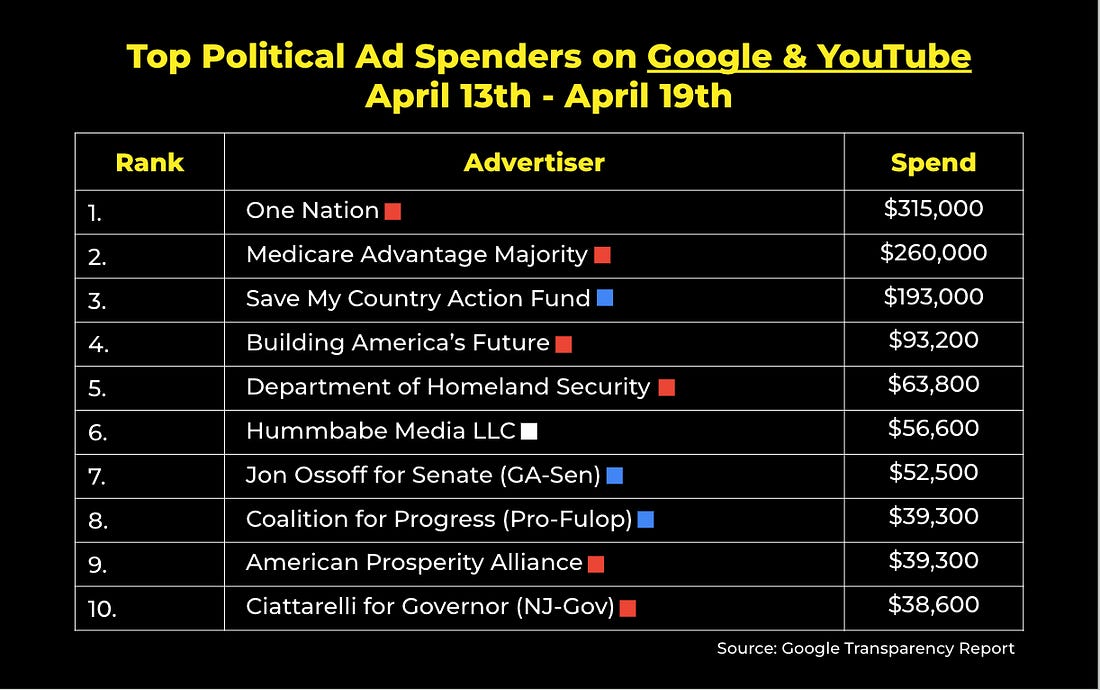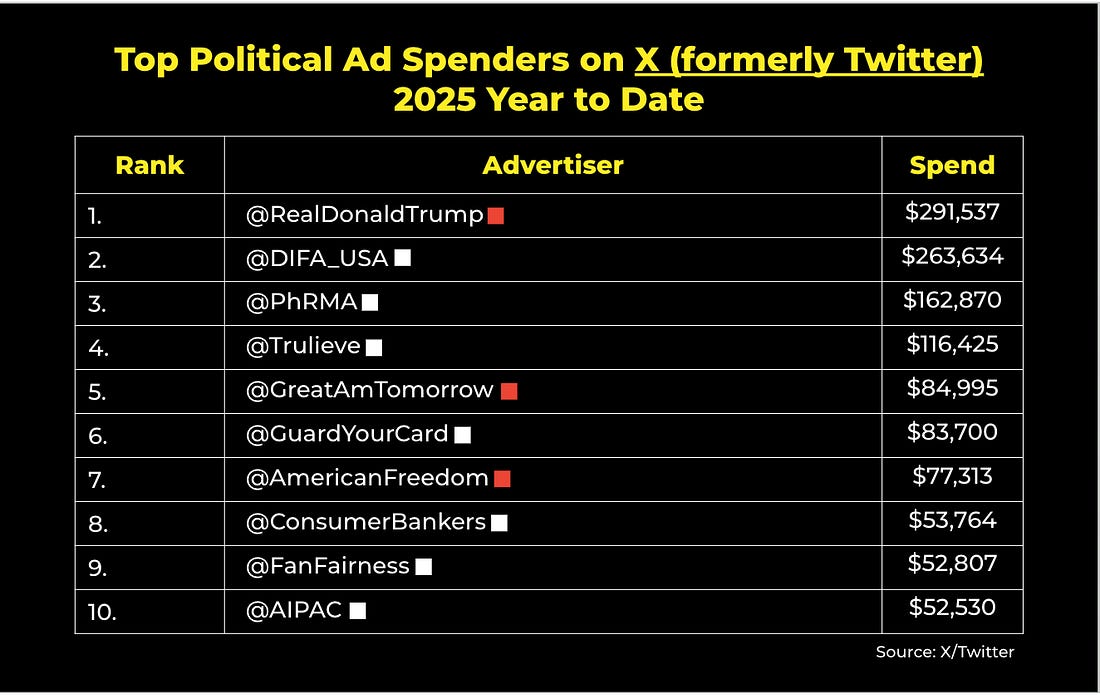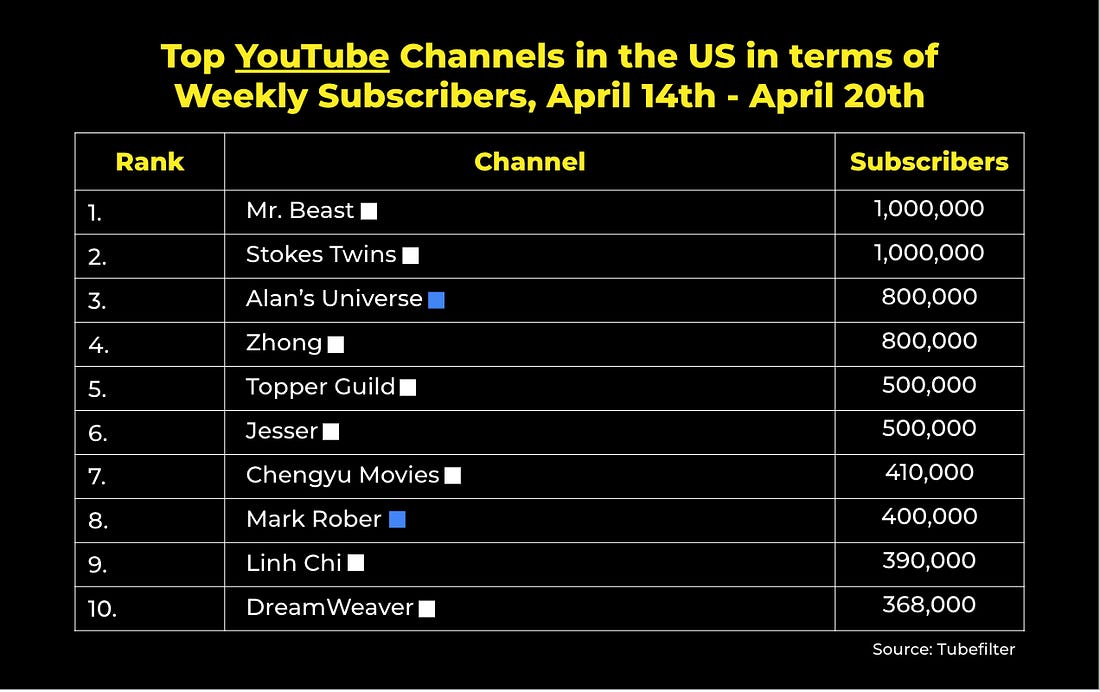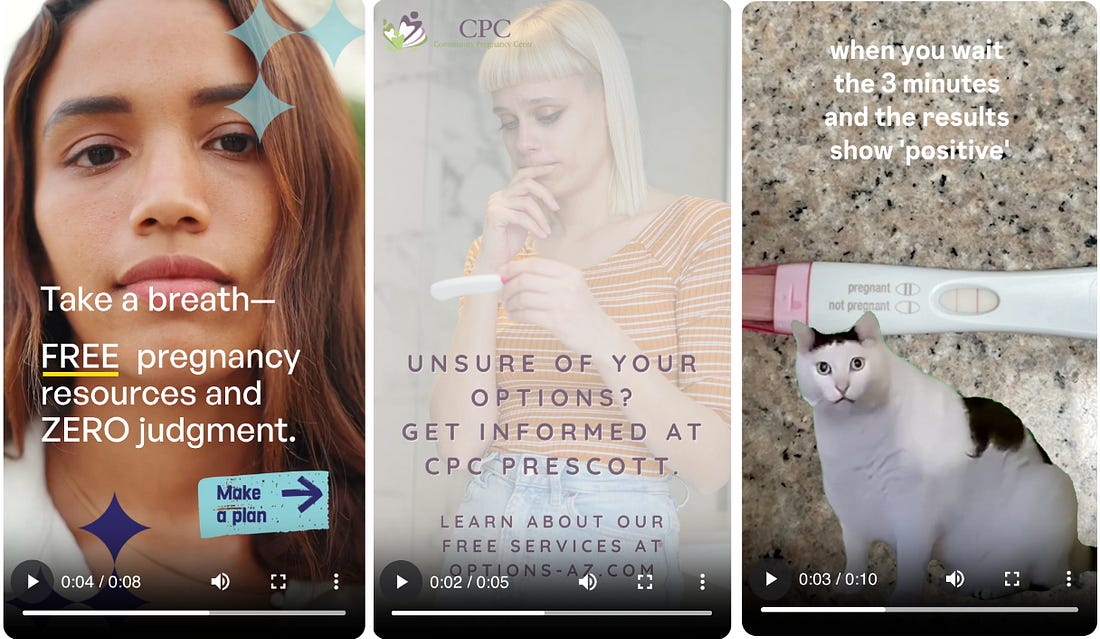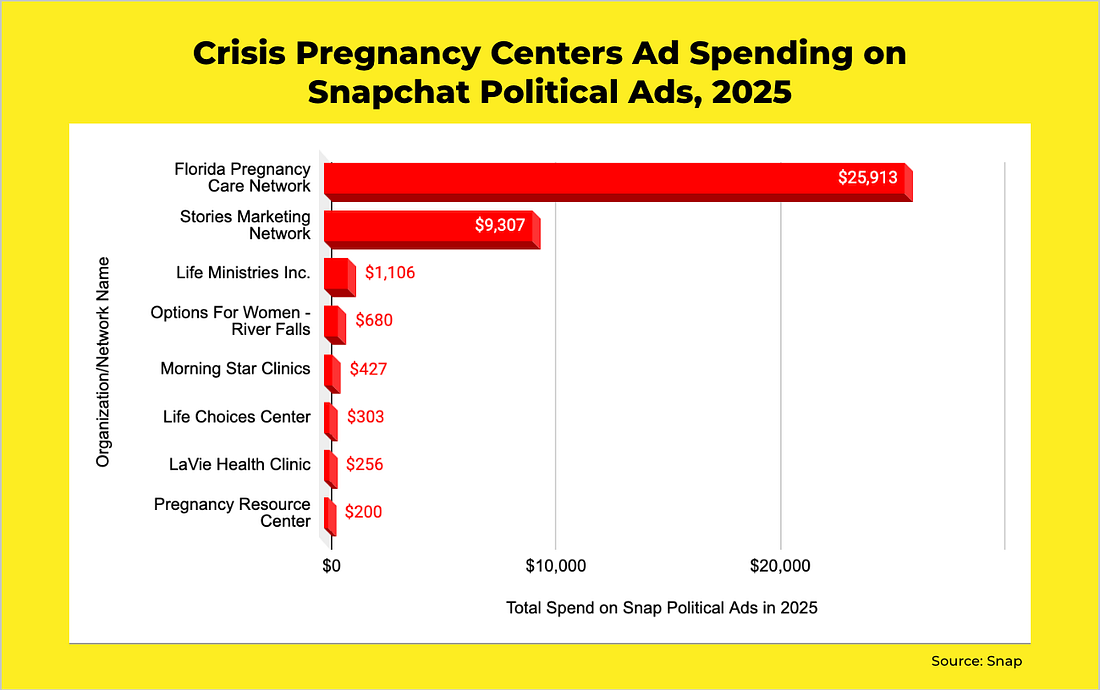Hey there, friends of FWIW 👋 First and foremost, I want to thank you for being a reader. We are a community of 24,000+ folks, and I am grateful for each and every one of you. I want to take a moment today to ask if you might consider becoming a paid subscriber to FWIW. Not only will you get access to exclusive clips round-up every Tuesday, but you will also be supporting the mission of FWIW and its parent company, COURIER, to provide pro-democracy news and information at a time when it is more critical than ever. Subscriptions are just $5 a month. You can sign up below 👇 Thanks for being here! Lucy The Crisis Pregnancy Center Playbook Goes DigitalAlso inside: Rep. AOC is talking about the massive crowds she’s drawn, a famous YouTuber takes heat from Elon Musk fans, and moreThis newsletter is sponsored by Ripple On Impact. Earlier this year, I noticed that crisis pregnancy centers (CPCs), also known as anti-abortion centers, seemed to be flocking to Snapchat political ads… with what seemed to be the intent to get their ads in front of teenagers and young women. More on that below, but first… Digital ad spending, by the numbers:FWIW, U.S. political advertisers spent about $11.6 million on Facebook and Instagram ads last week. Here were the top ten spenders nationwide: Rep. AOC spent $185,000+ this past week running Facebook and Instagram ads from her campaign disclaimer that highlight the record-breaking attendance that she and Sen. Sanders have had for their Fighting Oligarchy tour. The ads seem to contain a Hamilton reference, include a grassroots fundraising ask, and are running nationwide. And over in scammy world, similarly to what we covered earlier this month, a group called American Fair Insurance Group, which has essentially no online footprint and is linked to this random Facebook page, is running ads claiming that Elon Musk is warning people to get their concealed carry licences ASAP. There seems to be no evidence that Musk specifically said this… but the ads, as of publication, were still running on Facebook and Instagram. Meanwhile, political advertisers spent just over $2.2 million on Google and YouTube ads last week. These were the top ten spenders nationwide: One Giant Leap PAC, which is backing Rep. Mikie Sherrill in her bid for New Jersey governor, dropped $19,700+ this past week to boost Sherrill’s PAC’s first ad of her campaign on Google and YouTube. The ad specifically calls out Trump and Musk and is running pretty much exclusively in New Jersey. On X (formerly Twitter), political advertisers in the U.S. have spent around $2.7 million on ads in 2025. According to X’s political ad disclosure, here are the top spenders year to date: Tucker Carlson, AKA @TuckerCarlson, is apparently up with his first X/Twitter political ad spend of 2025: in the ads, Carlson complains that YouTube partially demonetized his recent video with Alex Jones because they used a slur and urges people to visit his website. …and lastly, on Snapchat, political advertisers in the U.S. have spent around $643,500 on ads in 2025. Here are the top spenders year to date: What’s trending on YouTube:Each week, we’re tracking the YouTube channels in the US gaining the most subscribers in partnership with our friends over at Tubefilter. Take a look: This week, I want to flag Mark Rober, a former NASA engineer and “friend of science” with 67.7 million subscribers – and 400,000 of them gained in the past week. Amidst the Tesla takedown of the past few months, Rober made massive waves in March by posting a video showing that Tesla’s self-driving car was able to be tricked. This seems to have made some fans of Elon Musk and Tesla very, very mad, although Rober himself actually said none of it was meant to be explicitly political (fittingly, here’s a YouTube explainer of the whole drama). We’ve Been Told It Sounds Too Good To Be True
The Crisis Pregnancy Center Playbook Goes DigitalAt the beginning of the year, I noticed that crisis pregnancy centers (CPCs), also known as unregulated pregnancy clinics or anti-abortion centers, seemed to be flocking to Snapchat political ads with what seemed to be the intent of getting their ads in front of teenagers and young women. In case you’re unfamiliar, here is a quick summary of CPCs from Planned Parenthood. Essentially, they are unregulated clinics that don’t usually have actual medical staff on site and often exist for the purpose of dissuading women from receiving abortion care – even though CPCs are often branded to look very similar to abortion clinics to draw people in. And that seems to be exactly what their aim is with Snapchat ads as well. Here’s a look at some of the ads currently running from these groups: As you can see, these ads are geared towards young people and don’t make any allusion to the anti-abortion groups or movements that many of them are backed by (financially and otherwise). Currently, I have identified at least 25 CPCs running political ads on Snapchat from at least 8 different providers/networks. Take a look: As a flag, Stories Marketing Network actually appears to be a Tennessee-based marketing firm that specializes in crisis pregnancy centers and anti-abortion marketing. They appear to be running local ads for 18+ CPCs in places like Olathe, KS, and Ithaca, NY, but for the purposes of this chart, and since they appear to be running essentially the same ads for multiple CPCs, I’m displaying them as one CPC organization/network. In total, these CPCs have spent $38,192 on Snap political ads in 2025 and have amassed over 1.9 million impressions. In comparison, the total of all political ad spending on Snapchat in 2025 is $643,500, and the total impressions amassed by those ads is 36,626,798. It’s also worth noting that this isn’t necessarily a new phenomenon – several of these groups appear to have been advertising on Snap last year as well. But just to give you a visual: This CPC political ad spending on Snapchat accounts for 5.6% of the total political ad spend in 2025, and their ads account for 4.9% of the total impressions from all the Snap political ads in 2025. That may not seem like a *huge* deal, but recall that the goal of these ads doesn’t seem to be large reach, but rather reaching the right people in the vicinity of the CPC. Looking at these ads, many of them are very specifically geo-targeted. However, the part that is even more notable is who exactly they are targeting: teenage girls and young women. Many of these ads are targeting women starting at ages 15 or 16. This ad, in particular, from a CPC in Georgia, appears to be targeting people under the age of 20. The Snap political ad policy explicitly states that ads that are misleading – as some may argue these are, given that they follow the general messaging of CPCs in misleading people about their true intentions – are not allowed on the platform. It is unclear at this time whether or not these CPC ads would be, in fact, considered a violation of that policy. We’ve Been Told It Sounds Too Good To Be True
More from around the internet:
Our weekly clips round-up is back! Every Tuesday, paid subscribers will get a debrief on the stories about politics, tech, social media, media, and journalism you need to be tracking. If you haven’t signed up yet, you can right here ⬇️ That’s it for FWIW this week. This email was sent to 24,324 readers. If you enjoy reading this newsletter each week, would you mind sharing it on X/Twitter, Threads, or Bluesky? Have a tip, idea, or feedback? Reply directly to this email. |

